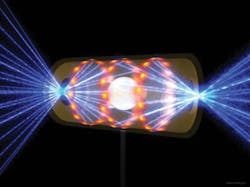
Press reports claiming a breakthrough in laser fusion at the Lawrence Livermore National Laboratory (Livermore, CA) in late September 2013 are exaggerated. A new test in an ongoing series of experiments at the National Ignition Facility did increase the yield of energy from fusion neutrons, but still was far short of ignition, and uses a configuration not expected to reach ignition.
A BBC report heralding a fusion "milestone" launched a series of follow-on stories, including some reporting that the NIF test produced more energy than it used. The BBC report is correct in saying that a late September yielded fusion (thermal) neutrons carrying more energy than the cryogenic deuterium-tritium fuel pellet absorbed from the laser pulse. The misunderstanding comes from the fact that the target absorbs only a small fraction of the 1.8 MJ in the laser pulse. In the indirect drive used at NIF, the laser pulse illuminates a metal shell called a hohlraum, producing x-rays that heat and compress the nuclear fuel in an effort to trigger fusion. Energy is lost in both steps, and the target absorbs only a small fraction of the laser energy.
The latest test continues the "High-Foot" series designed to improve control over the target implosion and avoid disruptions that had limited compression. By increasing energy delivered in the initial part of the pulse (the "foot"), the high-foot trials improved control of the implosion, at the cost of lower compression in the later stages. An August 2013 test tripled neutron yield to nearly 3 x 1015 or about 8 kJ. The late-September test apparently generated somewhat more energy, but Livermore could not comment because of the government shutdown."The results are important because they show we are gaining an understanding of performance," says Robert McCrory, director of the Laboratory for Laser Energetics at the University of Rochester (Rochester, NY). "The high foot design does not scale to ignition, but perhaps can be used to demonstrate significant alpha heating—a milestone that was not completed in the National Ignition Campaign that ended in 2012"—if the foot pulse is made slightly weaker.
McCrory notes that the September results fall short of the old goal of "scientific breakeven," which required generating as much energy from fusion as reached the target—not the smaller amount absorbed. Significant alpha heating requires generating 1016 neutrons, and is a step on the road to ignition, which requires generating at least as much energy from the fusion plasma as the NIF delivered to the hohlraum—nominally 1.8 MJ, the design energy of NIF pulses.
About the Author
Jeff Hecht
Contributing Editor
Jeff Hecht is a regular contributing editor to Laser Focus World and has been covering the laser industry for 35 years. A prolific book author, Jeff's published works include “Understanding Fiber Optics,” “Understanding Lasers,” “The Laser Guidebook,” and “Beam Weapons: The Next Arms Race.” He also has written books on the histories of lasers and fiber optics, including “City of Light: The Story of Fiber Optics,” and “Beam: The Race to Make the Laser.” Find out more at jeffhecht.com.

